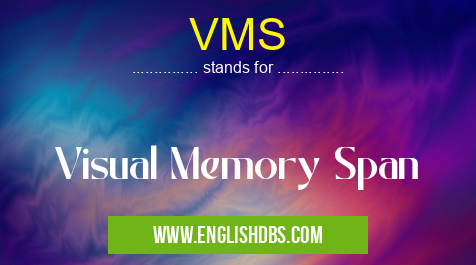What does VMS mean in PHYSIOLOGY
Visual Memory Span, often denoted as VMS, is a measure of how much information a person can recall after seeing it visually. It is typically administered by presenting a series of visual images and asking the test taker to remember as many images as possible in order from the beginning to the end of the sequence. This measurement is an important consideration when evaluating cognitive abilities such as mental processing speed and memory capacity.

VMS meaning in Physiology in Medical
VMS mostly used in an acronym Physiology in Category Medical that means Visual Memory Span
Shorthand: VMS,
Full Form: Visual Memory Span
For more information of "Visual Memory Span", see the section below.
» Medical » Physiology
Clinical Use
Visual Memory Span testing is essential when assessing various neurological conditions such as Attention Deficit Hyperactivity Disorder (ADHD) or learning disabilities like dyslexia. It can also be used to detect underlying brain abnormalities associated with syndromes like Autism Spectrum Disorder (ASD) or Alzheimer’s Disease (AD). Additionally, VMS testing is also useful when diagnosing the effectiveness of medications that affect cognitive processes such as stimulants or anti-anxiety medications. By measuring the patient’s visual memory span before and after taking these medications, clinicians are able to assess how well they are working for that individual patient.
Essential Questions and Answers on Visual Memory Span in "MEDICAL»PHYSIOLOGY"
What is Visual Memory Span?
Visual Memory Span (VMS) is a testing technique used to measure the amount of visual information an individual can remember and recall. It involves presenting a set of geometric designs or symbols, such as objects, shapes, letters and numbers in a certain order, and then asking the participant to replicate that order from memory. The accuracy of reproduction determines the individual's VMS score.
How is Visual Memory Span related to cognitive abilities?
Visual Memory Span is related to cognitive abilities because it tests an individual's ability to remember and recall visual information accurately. This task requires basic visual perception skills such as pattern recognition and short-term memory. It also tests higher level skills such as problem solving, logical thinking, and creative thinking.
What are some common uses for Visual Memory Span testing?
Visual Memory Span testing has many applications in psychology research and clinical settings. It can be used to assess both the current status of an individual's cognitive functioning as well as track changes over time. It can also be used to diagnose developmental disorders such as autism spectrum disorder or attention deficit hyperactivity disorder (ADHD). In addition, it can be used in educational settings to identify students with learning difficulties or special education needs.
What types of tasks are included in Visual Memory Span testing?
Common tasks include memorizing sequences of images or symbols presented visually on a computer screen; recognizing patterns after having seen them once; reproducing sequences based on verbal cues; verbally describing patterns accurately; and recognizing similarities between two different patterns or sequences after comparing them side-by-side.
How long does it typically take to complete a Visual Memory Span task?
The length of time required for completion varies depending on the complexity of the task being tested but usually only takes 5–10 minutes to complete.
How is performance measured in Visual Memory Span testing?
Performance is measured based on both accuracy and speed, with accuracy taking precedence over speed when assessing results. Errors may be either incorrect responses or omission errors (i.e., omitting part of the sequence). Scoring is subjective but generally includes assigning points for each correct response with points deducted for any errors made on that trial.
What conditions can affect an individual’s performance on a Visual Memory span test?
A variety of factors can influence an individual’s performance on a VMS test including age, intelligence level, educational history, physical health conditions such as vision impairment or hearing loss, fatigue levels (especially if testing occurs late in the day), stress level due to external factors such as pressure from family members/peers/professionals etc., medication use etc., and even mood states such as anxiety which may interfere with focus levels needed when completing this type of assessment.
Is there any way I can prepare for taking a VMS test?
Preparation for taking a VMS test involves getting adequate rest before your scheduled assessment date so you are alert while doing the task provided by researcher or clinician conducting your evaluation session. Eating healthy small meals throughout the day prior will help boost your energy levels so you remain focused during your evaluation session.
Are there any risks associated with performing a VMS test?
Risks associated with performing this type of assessment are minimal since there are no negative consequences associated with getting incorrect answers or failing this type of task completely.
Final Words:
In conclusion, Visual Memory Span (VMS) testing is a valuable tool used in medical assessment in order to evaluate learning disabilities, neurocognitive disorders, brain abnormalities associated with syndromes or illnesses, and response to medication treatment plans. Understanding what VMS stands for and its clinical uses helps healthcare professionals make more informed decisions for their patients’ care plans.
VMS also stands for: |
|
| All stands for VMS |
